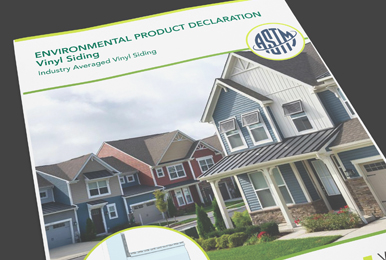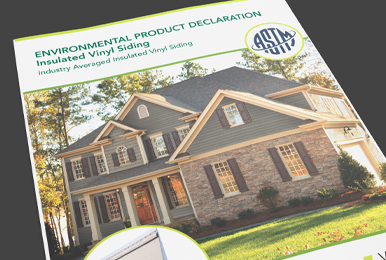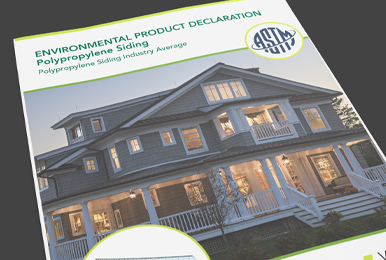New VSI EPDs Take Innovative Marketing Approach to Promote Vinyl Siding’s Sustainability and Quality Performance with a Strong Focus on Embodied Carbon
If you read only one set of Environmental Product Declarations (EPDs) this year, you have to check out the Vinyl Siding Institute’s (VSI) newly-released EPDs for vinyl siding, insulated vinyl siding and polypropylene siding.
In a world where standard EPDs often put architects, home builders and even the techiest code officials to sleep, the new VSI EPDs tell the inspiring lifecycle story of the cladding industry’s most sustainable products. Created for architects and homebuilding professionals by homebuilding professionals (who serve on VSI’s Sustainability Committee), these innovative EPDs make it easy for key stakeholders to understand why they should “spec” vinyl siding.
What sounds like gimmicky marketing speak is actually a celebration of the Facts & Science of vinyl siding’s sustainability and performance advantages that have been buried in EPDs. An EPD, by definition, is a report that tells the lifecycle story (including its environmental impact) of a product in a single, comprehensive document. Because it is a data-driven report, there is no story being told, at least not one that a majority of building professionals can understand.
This year, VSI and its Sustainability Committee changed that by designing a user-friendly piece that those in the field can more effectively utilize. The reports start with 10 bullet points on the clear sustainable advantages of vinyl siding, followed by product pics and visually-pleasing graphics to demonstrate vinyl siding’s lower carbon footprint and recyclability, its longevity and materials sustainability.

It also lists nationally-recognized programs offering green credits for vinyl siding. The product environmental data comes at the end of the report, but after reading the compelling lifecycle story chronologically arranged in six 1-page chapters, the “technical stuff” is much more comprehensible. “The greatest marketing tool we are using is the facts and science,” said Lisa Dunn, VSI’s Director of Communications. “The design and creative approach align with VSI’s commitment to educating building professionals about how vinyl and polymeric sidings are high-performing, sustainable building materials.”
Members of VSI’s Sustainability Committee and Marketing Committee – who developed the idea of designing the EPDs for use in the field – felt strongly that the EPDs had to be user-friendly for the majority of their customer base who have non-technical backgrounds.
“As manufacturers, any time that we can create a user experience that makes it easier for people to do business with us, we’re all over it,” said Eric Cotterman, VSI Sustainability Committee Chair and Product/Installation Trainer at Cornerstone Building Brands. “We like how it shows our customers why the EPD is important. Previously, customers complained that it was hard for them to read. But not anymore. And the data is still there for the engineers who need it.”

According to Cotterman, the traditional EPDs are so data-driven that people wouldn’t bother reading them if they didn’t understand the material. “Our new templates help guide them through each factor and make it easier for them to make decisions in using the product,” Cotterman explained.
The EPDs are mainly used by architects, engineers and specifiers of multi-family residential products. But with regulations moving to more rigid sustainable standards, EPDs will play an intricate part in single-family consideration. Therefore, having EPDs that are communicable to other stakeholders, including builders and consumers, will be a critical component for promoting vinyl siding’s sustainable benefits.
“Anywhere there’s a governing body making final decisions, especially for government funding and grants, they’re going to need those EPDs,” Cotterman noted.
A major component of the VSI’s success in developing the EPDs was the collaboration from a majority of VSI member manufacturers (five in total) who participated in the life cycle process. They strongly focus on the people being served – builders and building professionals, as well as consumers.

“The team effort that went into this was fantastic. Each manufacturer participated and shared great ideas and good information,” said Sal Vaccarino, Director – OEM and Home Improvement Channels at Progressive Foam Technologies. “The intention from everyone involved was never about trying to grow new sales, but to show how much better the environment can be and how vinyl products can help improve homes across the country.”
Vaccarino affirmed that the effort was geared toward articulating good technical information.
“Somebody always threw out the question: is this readable by the average Joe or Pam? And we kept that top of mind throughout the process. Because of this approach, the finished reports feature good details that people can absorb. They’ll know how the benefits of these products will help them in the long run. It was a terrific interaction among the manufacturers and VSI, as well as the technical, service and marketing people.”
While there is no disputing Vaccarino’s claims about the nobility of the project mission, the EPDs will serve as a powerful weapon for VSI member manufacturers against attacks by those who dismiss vinyl siding as “a cheap unsustainable plastic.” “The piece itself says it all and will showcase what vinyl siding products can do to help reduce emissions and other environmental factors… and make the world a better place to live, one house at a time.”
____________________________________________________________________________________
Don Browne is a writer, entrepreneur and local legislator who believes that the power of words can change the world. He provides unique writing services for clients in the construction, health care, IT and hospitality sectors. He has a passion for small business and start-ups, as well as writing about Irish history, family and corporate biographies. As a homeowner and father of four who is passionate about community development, Don looks forward to writing more about the exciting possibilities of creating traditional neighborhoods and more sustainable communities using modern materials.
